Samsung Galaxy A51 review: Is it still worth buying in 2021?
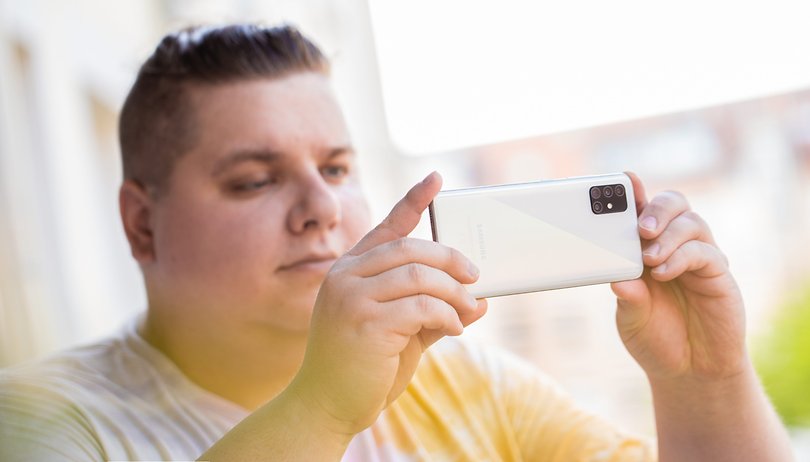

The Samsung Galaxy A51, a mid-range smartphone that was released in January 2020, proved to be a bestseller that received bouquets from the tech press and users as it offers fantastic value-for-money. A year on, I tested the Samsung Galaxy A51 to see if it is still worth picking one up today.
Good
- Excellent 60Hz AMOLED screen
- Adequate camera performance
- Guaranteed support up to Android 13 and 3 more years of security updates
- 3.5 mm jack and expandable storage
Bad
- Exynos 9611 performance
- Average battery life
- Fast charge is super slow
- No IP certification
- Does not offer value-for-money in 2021
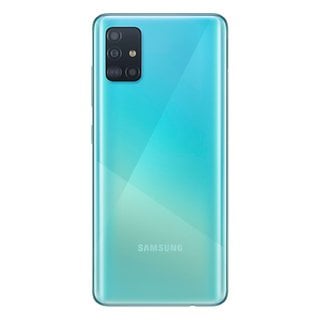
My brief opinion on the Samsung Galaxy A51
The Samsung Galaxy A51 is a mid-range smartphone that was first announced in December 2019 and launched in January 2020 at a $379 price point. In July 2021, the smartphone is no longer sold by Samsung officially, albeit carrying a $280 price tag on its official store.
If you want to pick one up now, I can only find it on third-party sellers in Marketplace in the 4GB RAM configuration only.
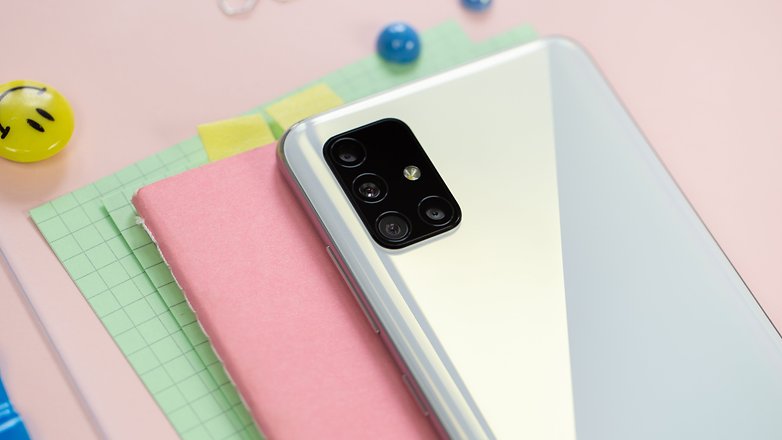
In terms of hardware specifications, there's an AMOLED display, a quad-camera module (48+12+5+5 MP), an Exynos 9611 SoC, and a 4,000 mAh battery that accepts wired 15 Watts fast charging.
If we begin at the starting price of $379, then the Samsung Galaxy A51 has no argument to make against a Redmi Note 10 Pro or a OnePlus Nord CE. Even if we were to take the current price of approximately $280, the competition remains fierce with the presence of the Realme 8 Pro or the Redmi Note 10 5G.
As we'll see in my full review, some elements of the Samsung Galaxy A51 still hold up well in 2021 such as its beautiful AMOLED display. Overall, I felt like I had an outdated model in my hands.
Design and screen: The plastic look hasn't aged one bit
When it comes to design and the display, the Samsung Galaxy A51 sports a flat 6.5-inch AMOLED panel with a plastic back, all crammed into a fairly massive 158.5 x 73.6 x 7.9 mm form factor while tipping the scale at 172 grams.
What I liked:
- The AMOLED screen remains very capable
- 3.5 mm jack and a microSD memory card slot
- Reflective effect of the coat on the back
- The slim camera module
What I disliked:
- 60Hz refresh rate
- Rough finish in certain places
- No IP certification
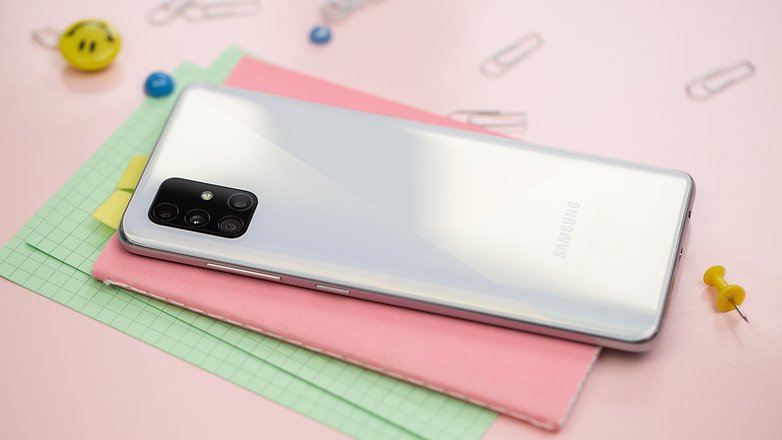
I really like the reflective effect that the back coating delivers in a pearly white color, complete with diagonals and vertical stripes.
I also liked the camera module that hardly protrudes, although this is partly due to the fact that the Samsung Galaxy A51 is rather thick. On the other hand, I find that the finish is not quite refined in selected areas, especially around the USB-C port and the 3.5 mm audio jack, where you can clearly see the deformation in the plastic frame at the entrance of the ports.
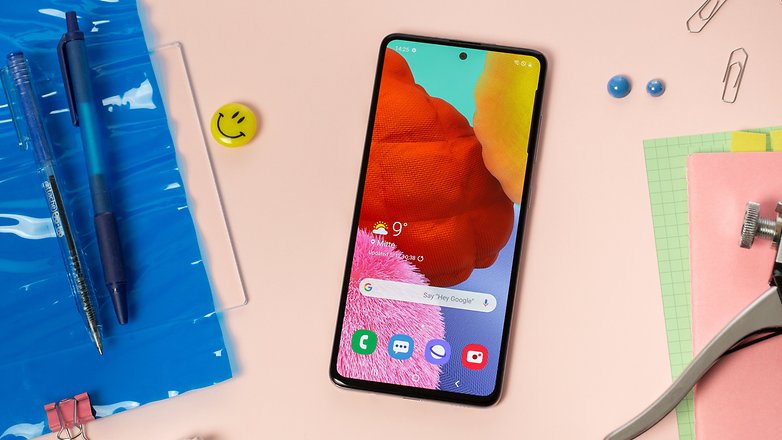
As for the display, you get a very good Super AMOLED panel that measures 6.55-inches across diagonally in Full HD resolution of 1080x2400 pixels, or 405 dpi pixel density. The maximum brightness of 630 nits (410 on average) is good enough without going overboard. The refresh rate maxes out at 60 Hz, but that did not bother me much, although I did see the difference compared to the 120 Hz refresh rates that my eyes are used to.
I also welcome the presence of a 3.5 mm jack, a dual SIM port and a microSD slot to expand storage up to 512GB. There is no IP certification, though.

Overall, the Samsung Galaxy A51 remains rather current visually in 2021, with the smartphone barely aging. I'm really not a fan of the "all-plastic" approach though. The screen is excellent, but I can't help but think of smartphones that are sold for less than $300 or even $200 that come with a higher refresh rate. Offering an AMOLED display on the mid-range device is no longer considered as a worthy feat in 2021.
Interface: OneUI 3.1 and another 3 years of guaranteed updates
The Samsung Galaxy A51 currently runs on OneUI 3.1 that is based on Android 11 and has received the May 2021 Android security patch.
I'm not going to go into detail about this Android skin that you are already familiar with. But the weakness of the Exynos 9611 SoC did not allow me to enjoy the excellent user experience that is normally associated with OneUI.
However, it's worth remembering that the smartphone was first released with OneUI 2.0 that is based on Android 10. And in line with Samsung's latest update policy, the Galaxy A51 will benefit from 3 major Android versions and 4 years of security updates.
If you buy this smartphone now, it will receive Android 13 as well as security patches up till 2023. Currently, the smartphone has already dropped to the bottom tier in terms of security update frequency. Thus, you will only receive one security update per quarter. This frequency is likely to be reduced to twice a year in the final year of its life cycle.
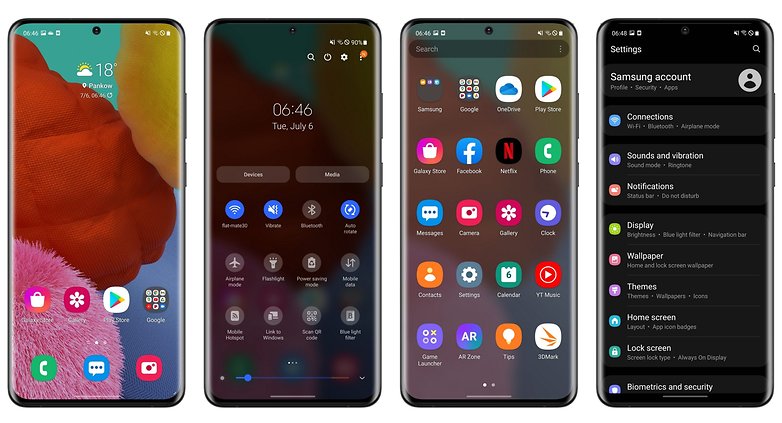
Despite being released last year, the Samsung Galaxy A51 is likely to be kept updated longer than its Redmi or Realme counterparts that were released in 2021.
Performance: Exynos 9611 falls short
The Samsung Galaxy A51 packs a 10 nm octa-core Exynos 9611 SoC and is mated to a Mali G-72 GPU and 4 GB of RAM.
What I liked:
- No overheating issues, which is something rare these days
What I disliked:
- Lackluster performance
- SoC was already not competitive in 2020
- Slowdowns in the interface
- Gaming experience was not very pleasant
Armed with a year-old mid-range SoC and an unfortunate 4 GB of RAM, you obviously shouldn't expect a performance monster.
On the contrary, the Samsung Galaxy A51 really struggled through everyday tasks. I experienced slowdowns in the interface, a delay when launching applications, or making transitions while multitasking. In normal use and without any application running in the background, 2.2 of the 4 GB RAM was used, leaving 525 MB available. So I only had effectively 1.3 GB of RAM available.
The slowness was also experienced when I installed the OneUi 3.1 update and the latest security patch, where the installation took a really long time to complete. And I won't even venture into in-game performance since most titles launch with "average" graphics by default and almost never run at 30 FPS constantly.
Samsung Galaxy A51
| Model/Benchmark | Samsung Galaxy A51 | Redmi Note 10 Pro (SD 732G) | Realme 8 Pro (SD 720G) |
|---|---|---|---|
| Geekbench single/multi | 348/1265 | 569/1780 | 568 / 1685 |
| 3DMark Wild Life | 853 | 1124 | 1052 |
| Passmark memory/disc | 12.829 / 34.829 | 18.743 / 38.325 |
19.799 / 38.683 |
The only positive point is that smartphones released in 2021 tend to overheat to the point of burning your fingers, which is something the Samsung Galaxy A51 would never do as it always remains at a reasonable temperature.
During my benchmark sessions using the 3DMark Wild Life Stress Test that simulates intensive gaming use, the Samsung Galaxy A51 maintained a low but constant performance level. On the other hand, it experienced a big drop in the frame rate during the last test loop every single time (3 sessions were performed in total), bringing down the overall score of the smartphone.

Overall, whether we refer to the $379 Samsung Galaxy A51 or the $280 that it is being sold for currently, the performance/price ratio is clearly not interesting enough to turn your head as you'll find far more competitive models from its competition. Concerning this point, the Samsung Galaxy A51 is undoubtedly outdated in 2021.
Photo: The 48 MP quad module still holds up well
The Samsung Galaxy A51 packs a quad-camera module with a 48 MP wide-angle main lens, a 12 MP ultra-wide-angle, and a duo of macro and depth sensors of 5 MP each.
What I liked:
- The camera module remains competitive in 2021
- Correct daytime wide-angle shots
- Wide dynamic range
- Colorimetry is well-managed despite a slight saturation
What I disliked:
- Disappointing night mode performance
- A lot of distortion with its ultra wide-angle lens
- Limited digital zoom
- Fussy focus performance in macro
48 MP main lens
 Main lens 1x Main lens 1x |
 Main Lens 1x Main Lens 1x |
 Main Lens 1x Main Lens 1x |
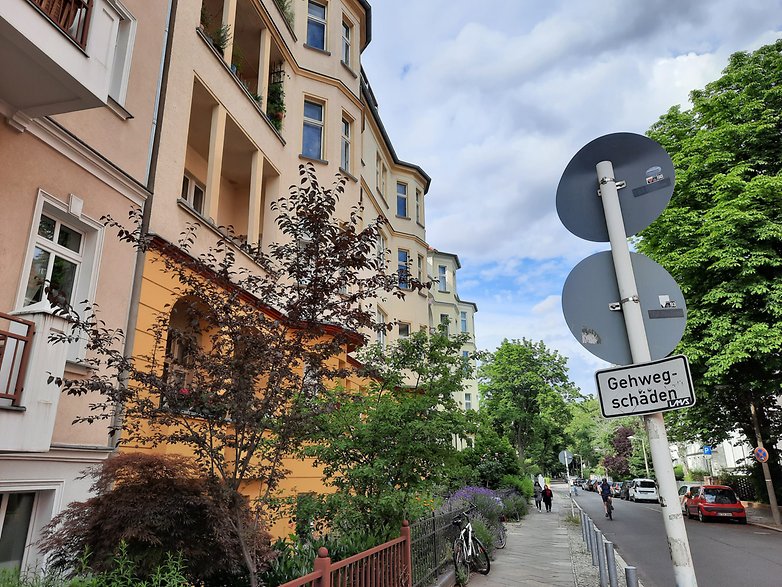 Main lens 1x Main lens 1x |
During the day and under good lighting conditions, the Samsung Galaxy A51's camera module still holds up very well and shows us just how little the photography hardware has evolved in mid-range smartphones over a year.
Photos captured with the main 48 MP sensor are not mind-blowing, but the level of details is correct, with a wide-enough dynamic range even when it involves a complex exposure setting. Colors are flattering to look at, although Samsung has the tendency of saturating colors until it displeases many users.
12 MP Ultra Wide-Angle
 Main lens 1x Main lens 1x |
 Ultra Wide Angle Lens 0.6x Ultra Wide Angle Lens 0.6x |
12MP Ultra Wide-Angle
 Main Lens 1x Main Lens 1x |
 Ultra Wide-Angle Lens 0.6x Ultra Wide-Angle Lens 0.6x |
The ultra wide-angle is also rather effective with its wide FOV of 123°. However, you'll have to contend with very pronounced distortion at the edges of the image as well as more random exposure management, which can sometimes lead to inconsistency with shots when captured at wide-angle.
Ultra Wide-Angle 12 MP
 Main lens 1x Main lens 1x |
 Ultra Wide Angle Lens 0.6x Ultra Wide Angle Lens 0.6x |
12 MP Ultra Wide-Angle
 Main Lens 1x Main Lens 1x |
 Ultra wide-angle lens 0.6x Ultra wide-angle lens 0.6x |
As for the zoom, you have to make do with a purely digital magnification from the main lens ranging from 2x to 10x.
Zoom 2x, 5x, and 10x
 Main lens 2x Main lens 2x |
 Main lens 5x Main lens 5x |
 Main lens 10x Main lens 10x |
With such low magnification, there is at least a better chance to obtain a usable result. I think the results are quite good as long as you limit yourself to just 2x zoom.
Zoom 2x, 5x, and 10x
 Main lens 2x Main lens 2x |
 Main lens 5x Main lens 5x |
 Main lens 10x Main lens 10x |
On the other hand, I was very rarely convinced by the results of the 5x and 10x photos. This is especially since without the presence of optical stabilization, the focus runs all over the place capricious and you won't always escape motion blur as you can see below.
Zoom 2x, 5x, and 10x
 Main lens 2x Main lens 2x |
 Main lens 5x Main lens 5x |
 Main lens 10x Main lens 10x |
As for the macro sensor, I found it refreshing that a model released in 2020 doesn't settle for a 2 MP module like most of the smartphones did in 2021. I found the focus area to be too narrow and while it suffered from the same stabilization concerns, the macro photos turned out pretty nice to me when all of the right conditions were met (at least 1 out of 2, as shown below).
5 MP macro lens
 Macro lens Macro lens |
 Macro Lens Macro Lens |
 Macro lens Macro lens |
 Macro lens Macro lens |
At night, I found the shots to be disappointing overall. The night mode does manage to catch up a bit with the scene by lighting it up more to show more details. But the software processing is too aggressive and we often ended up with too much digital noise.
Night mode
 Main lens 1x Main lens 1x |
 Main lens 1x Main lens 1x |
Overall, I found that the Samsung Galaxy A51's camera module hasn't aged that much compared to what you can find in this price range this year. The photo rendering is not that great, but I rather enjoyed most of the shots that I was able to capture with this smartphone.
Battery life: Super slow charging speed by today's standards
The Samsung Galaxy A51 packs a 4,000 mAh battery that accepts 15-watts of wired "fast" charging.
What I liked:
- -
What I disliked:
- Average battery life
- Fast charging is too slow
A 4,000 mAh battery capacity is considered to be rather low these days, especially for a mid-range smartphone.
With typical usage and an average screen time of 6 hours per day, I was able to last for slightly more than 12 hours before seeing the battery life fall below the 20% mark. My best 'score' was 14h 22m when I went out for a photo shoot over the weekend and my screen time was slightly more limited (4h 30m).
On the other hand, the charging time was unbearably long. I know iPhone users won't understand why I'm making such a big fuss out of this since they're used to 20-watt charging. But I think Samsung is seriously lagging behind in this regard, even with 25-watt in its flagships.
Apart from the performance, this is where the real problem lies. If it takes more than 1h 30m to fully charge a mid-range smartphone in 2020, this is no longer the case in 2021.
The Samsung Galaxy A51 offers an average battery life and nothing else. Far faster and better charging capabilities can be found for the same price on 2021 models. But the real problem is its 'fast charging', which is not fast at all.
Technical specifications
Samsung Galaxy A51
| Components | Specifications |
|---|---|
| Processor |
|
| Memory |
|
| Expandable storage? | Yes |
| Screen |
|
| Camera module |
|
| Video |
|
| Battery |
|
| OS | OneUI 3 based on Android 11 (released with Android 10 by default) |
| Audio | 3.5 mm jack |
| Connectivity | Wi-Fi 6 / Bluetooth 5.0 / LTE / NFC |
| IP certification | None |
| Dimensions & Weight |
|
| Colors | Prism Crush Black, Prism Crush White, Prism Crush Blue, Prism Crush Pink |
| Price | $280 as of July 2021 |
Conclusion
Personally, I don't think the Samsung Galaxy A51 remains a good choice to pick up in 2021.
The smartphone is still competitive in some aspects including the screen quality and the decent performance of its 48 MP quad-camera module.
Samsung's 4-year software support makes the Galaxy A51 more durable than almost all of its competitors released this year at the same price.
But based on its launch price of $379, I'd rather pick up a Redmi Note 10 Pro with its 120Hz AMOLED display, 108MP main camera module, and 5,020mAh battery that offers 33W fast charging, all for $299 for the 6 GB RAM/128 GB configuration.
Even if we were to take the current price around $270, I would rather choose a Realme 8 Pro with a 60 Hz AMOLED display, a quad-camera module with a 108 MP primary sensor, and its 4,500 mAh battery that supports 50W fast charging for just $279 for the 8 GB RAM/128 GB version.
All the more important, I could not locate the Samsung Galaxy A51 as a new device from "official" e-tailers. For a Marketplace purchase, I find the price/performance ratio to be an uninteresting affair. Hence, I won't advise you to pick up the Samsung Galaxy A51 in 2021.








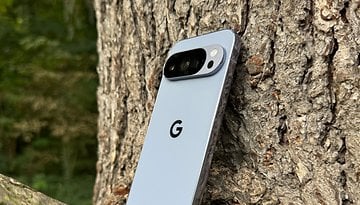
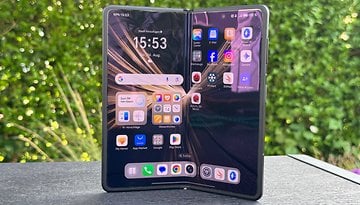
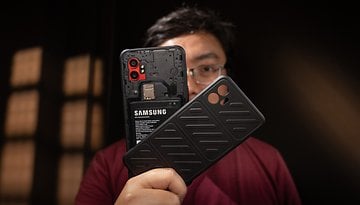
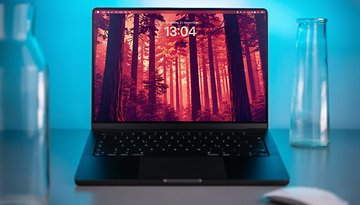

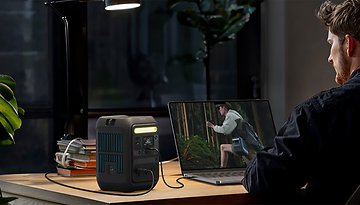
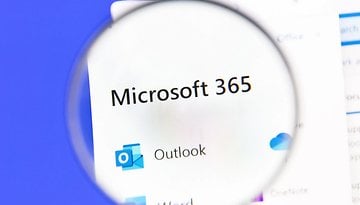






I have 51 Samsung now, and I am absolutely satisfied.
Had it for 3 years. The phone is slowing down so much. Considered upgrading it to an S20 in Dec 2022 so yeah. Wait till the phone really slows down. Maybe your opinion might change. :/